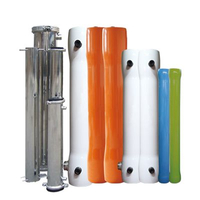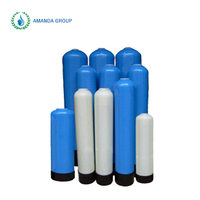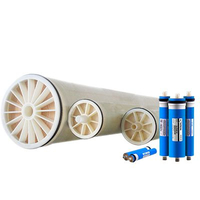What is FRP Membrane Housing?
FRP membrane housings, also known as membrane pressure vessels, are complementary products for reverse osmosis, sodium filtration, ultrafiltration and other devices, manufactured by computer programmed winding units and high performance processing equipment.
Requirements for the use of FRP membrane housing.
1. Comply with the rated design pressure index, use within the allowable value, overpressure operation is strictly prohibited.
2. The normal working temperature of FRP membrane housing is generally between -7°C and 49°C. It is strictly forbidden to work beyond this temperature range.
3. The FRP membrane pressure vessels can withstand a PH range of 3-10.
4. The back pressure should not exceed 125PSI.
5. Conventional fluid media is clear water, sewage, seawater, if used for special fluids, please contact water treatment professionals in advance to avoid accidents.
6. When the system is working or there is pressure in the membrane pressure vessels, it is strictly forbidden to knock, disassemble or move the membrane shell, and strictly control the influence of surrounding vibration sources.
Features of FRP Membrane Housings.
1. Excellent and reliable inner quality
The FRP membrane shell is manufactured by a computer program-controlled winding unit and high-performance processing equipment. The main materials are epoxy resin and fibres, which are treated by a special process to make the FRP membrane pressure vessels achieve advantages in pressure resistance, temperature resistance and corrosion resistance that are incomparable to ordinary steel and plastic materials.
2. Excellent insulation performance
The thermal conductivity of FRP membrane housing is generally within the range of 0.15-1.36W(m.k) at room temperature, which is only about 1/200. its thermal insulation performance is incomparable to that of metal materials. This property is of great benefit to the reverse osmosis membrane inside the membrane shell, which has little effect on the membrane from the outside temperature.
3. Outstanding corrosion resistance
Glass fiber and epoxy resin combination ratio after special curing treatment, the formation of natural corrosion-resistant products, the inner surface of the smooth and coating to a low concentration of acid, alkali, salt, oil and other solvents have good stability. It makes it possible to effectively inhibit seawater and microorganisms that enter the shell, and there is absolutely no corrosion in long-term use.

4. Structural design
The barrel, head and slots of the membrane shell have undergone strict layering design and optimised calculation details to ensure structural safety. The opening on the thick water side has been optimised to meet the necessary safety pressure of four side openings on one head and to enhance the variability in the installation process.
5. Reliability of components
The end plate is an important part of the membrane shell assembly and has high strength, excellent pressure and high pressure resistance. The seal design is a professionally designed "V+X" ring with an O-shaped end plate seal to ensure that it does not leak under low and high temperatures. The sealing design of the side opening is a combination of L-shaped drums and round gaskets to ensure a better sealing of the side opening in case of angular deflection. The side opening is fastened with a lift-up fastener to make it more adjustable.
In addition, the membrane housing, as the housing of the membrane element, can be used continuously for a long period of time. However, to ensure the long-term efficient use of the membrane housing, please strictly follow the operating temperature range (-7c to 49c) that the product can withstand and do not work outside this temperature range.
How to Install FRP Membrane Housings?
Before performing any operations on the FRP membrane housing, familiarise yourself with the product parts drawing for identification. Incorrectly assembling the FRP membrane shell or using rusted membrane shell components can seriously affect the sealing performance of the membrane shell and leave a safety hazard.

1. Carefully review the engineering drawings of the membrane shell to be installed to clarify each key dimension and technical requirements.
2. Design and manufacture brackets according to the engineering drawings and system capacity, the design of the brackets should take into account not only the support of the membrane shell, but also ensure the support structure of the piping and network.
3. Check that the membrane shell to be installed is in good condition, with emphasis on the inner surface of the shell and the raw/intense water inlet sealing surface.
4. Install the membrane shell on the positioned saddle, ensuring that there is sufficient space at both ends of the shell to install and uninstall the membrane elements, and aligning the raw/concentrated water ports at the end of the shell.
Note: The membrane housing should be installed to avoid stress concentrations where possible. If the raw/concentrated water end is fixed, the membrane housing should be mounted centrally on the support.
5. To install the straps, put the strapping bolts through the mounting holes in the bracket and use a spanner to screw the bolts into the nuts of the straps with a torque of 3 to 5 N.m. This allows the straps to secure the membrane shell to the saddle and at the same time gives the membrane shell sufficient expansion space.
6. Connecting the membrane housing raw/intense water port piping.
7. Assembling the end caps
8. Loading the membrane elements.
9. Installing the thrust ring at the thick water end
10. Closing the membrane housing
11. Connecting the clean water outlet line.
12. Check, including but not limited to, the fixing position of the membrane shell, the closure of the membrane shell and the connection of the piping.
13. Pressurize and start the system.
The above is the installation steps and precautions for FRP membrane shells, which are installed with reverse osmosis membranes and used for deep treatment of raw water, such as desalination of seawater. The correct use of FRP membrane shell helps to improve the efficiency of water production and ensure the stability of water quality.





